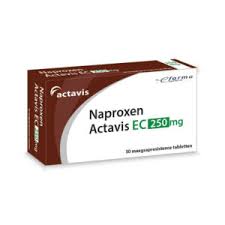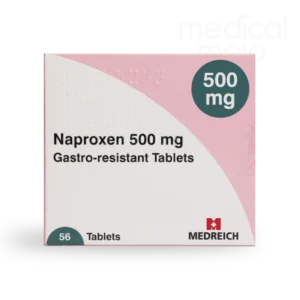If you are in pain, you want an effective painkiller, but you also don’t want to take a medicine that has a whole host of side effects that could cause problems down the line. In this article, we will answer the question, “Is naproxen a painkiller?” We will also go over how naproxen works, its side effects, and how to take it safely.
If you don’t feel like reading the whole article, you can use the navigational table below to skip the areas that interest you.
-
 Naproxen Gastro-Resistant Tablets 250mgPrice range: £19.99 through £38.99
Naproxen Gastro-Resistant Tablets 250mgPrice range: £19.99 through £38.99 -
 Naproxen Gastro-Resistant Tablets 500mgPrice range: £34.99 through £65.99
Naproxen Gastro-Resistant Tablets 500mgPrice range: £34.99 through £65.99
Introduction to naproxen
In today’s fast-paced world, pain management has become essential to maintaining daily activities. Among the many options available for pain relief, naproxen stands out as a commonly used medication. This blog aims to explore the question: Is naproxen a strong painkiller? We will delve into its mechanism of action, efficacy, potential side effects, and safety considerations.
What is naproxen?
Naproxen is classified as a non-steroidal anti-inflammatory drug (NSAID) (Ghlichloo et al., 2024). It is widely utilised to alleviate pain and reduce inflammation. Commonly available over the counter, naproxen can also be prescribed for more chronic or severe conditions.
It is important to understand that naproxen is not a one-size-fits-all solution. Its effectiveness can vary depending on the type of pain being treated. Conditions that typically benefit from naproxen include arthritis, muscle pain, menstrual cramps, and gout (Brutzkus et al., 2023).
Naproxen is often preferred by those seeking longer-lasting pain relief, as its effects can last up to 12 hours (DeArmond et al., 1995). This feature distinguishes it from other over-the-counter pain relievers, such as ibuprofen, which may require more frequent dosing.
How does naproxen work?
To comprehend whether naproxen is a strong painkiller, it is crucial to understand how it functions within the body. Naproxen operates by inhibiting the activity of enzymes known as cyclooxygenases (COX-1 and COX-2) (Bruno et al., 2014). These enzymes play a significant role in the production of prostaglandins, which are substances that promote inflammation, pain, and fever.
When naproxen blocks the COX enzymes, it decreases prostaglandin production, which results in diminished inflammation and pain. This mechanism is particularly beneficial for conditions characterised by swelling and discomfort, such as arthritis or muscle injuries.
Is naproxen a strong painkiller?
When assessing whether naproxen is a strong painkiller, it is essential to consider the context of its use. Naproxen is generally effective for managing mild to moderate pain. For example, it is often recommended for:
- Gout: Naproxen is particularly useful in treating gout, especially during acute flare-ups when pain and inflammation are at their peak.
- Muscle Pain: Strains and minor injuries can benefit from naproxen’s anti-inflammatory properties.
- Menstrual Cramps: Many women find significant relief from painful menstrual symptoms using naproxen.
- Arthritis: For chronic conditions like osteoarthritis or rheumatoid arthritis, naproxen can help manage daily discomfort.
However, for severe pain, such as that associated with major surgeries or acute injuries, naproxen may not suffice on its own. In these cases, stronger opioids or other pain management strategies may be required. Compared to other over-the-counter medications, naproxen’s more prolonged duration of action can make it a more convenient option for individuals who prefer fewer doses throughout the day. While ibuprofen typically requires administration every 4-6 hours, naproxen can be taken every 8-12 hours, depending on the individual’s needs.
When to use naproxen?
Naproxen is a versatile medication that can be used in various scenarios, including:
- Chronic Pain Conditions: Conditions like arthritis or back pain where inflammation plays a significant role.
- Acute Pain Situations: Situations like sports injuries, where swelling and pain are immediate concerns.
- Menstrual Discomfort: Many individuals find naproxen particularly effective for alleviating menstrual cramps.
- Postoperative Pain: After minor surgeries, naproxen may help manage pain and inflammation.
It is always advisable to consult with a healthcare professional to determine whether naproxen is appropriate for your specific situation.
Possible side effects of naproxen
While naproxen is generally considered safe for short-term use, it is not without its potential side effects. Some common side effects include:
- Gastrointestinal Issues: Stomach upset, heartburn, or nausea are among the most frequently reported side effects. Taking naproxen with food can help mitigate these symptoms (Pellicano R., 2014).
- Dizziness or Drowsiness: Some individuals may experience light-headedness or fatigue.
- Increased Blood Pressure: Regular use of naproxen may lead to elevated blood pressure levels (Pope et al., 1993).
- Kidney Effects: Prolonged use or high doses may affect kidney function, particularly in individuals with existing kidney issues (Baker et al., 2020).
More serious side effects, though rare, can include gastrointestinal bleeding, liver problems, and allergic reactions. Symptoms to watch for include severe stomach pain, unusual bruising, or swelling of the face or throat. If you experience any of these symptoms, it is crucial to seek medical attention immediately.
How to take naproxen safely
To maximise the benefits of naproxen while minimising risks, consider the following guidelines:
- Adhere to Dosage Instructions: The typical adult dose is naproxen 250mg–naproxen 500mg, taken every 8-12 hours as needed. Do not exceed 1g in 24 hours unless a healthcare professional advises.
- Take with Food: Consuming naproxen with food can help protect your stomach lining and reduce the risk of gastrointestinal discomfort.
- Stay Hydrated: Drink plenty of water while taking naproxen to support kidney function.
- Limit Alcohol Consumption: Alcohol can increase the risk of gastrointestinal bleeding when combined with NSAIDs like naproxen.
- Consult Your Doctor: Particularly if you have pre-existing medical conditions, such as heart disease, kidney problems, or a history of gastrointestinal issues.
Alternatives to naproxen
If naproxen does not seem suitable for your needs, there are several alternatives available for pain management:
- Ibuprofen: Another widely used NSAID, ibuprofen may be more effective for some types of pain but requires more frequent dosing.
- Aspirin: This NSAID can relieve pain and has anti-inflammatory properties, but it may irritate the stomach lining.
- Topical Treatments: Creams and gels containing NSAIDs or other pain-relieving agents can provide localised relief without systemic effects.
- Physical Therapy and Exercise: For chronic pain, non-pharmacological approaches such as physical therapy or regular exercise can be beneficial in managing symptoms.
Always consult a healthcare provider before trying new medications or treatment approaches to ensure they align with your specific health needs.
Medical Mojo conclusion on naproxen
In summary, naproxen is a valuable tool for managing pain, particularly for inflammation-related conditions. While it is effective for mild to moderate pain relief, its strength may not be sufficient for severe pain scenarios. Its prolonged duration of action and accessibility make it a popular choice among young adults seeking relief from muscle pain, gout and menstrual discomfort.
However, as with any medication, it is essential to use naproxen judiciously, be aware of potential side effects, and adhere to recommended dosages. For those considering using naproxen, it is advisable to consult a healthcare professional to determine if it is appropriate for your circumstances.
If you want to purchase naproxen, you can easily find it at Medical Mojo. The online platform offers a variety of medications, allowing you to find what you need for effective pain relief.
Where to buy naproxen?
To acquire naproxen conveniently, visit Medical Mojo, where you can find a selection of pain relief options. Always consult a healthcare professional before beginning any new medication to confirm it is the right choice for your health.
Disclaimer: This article is for informational purposes only and does not replace professional medical advice.
Get medicines tailored to you
Our compounding service gives you treatment built around your unique needs.
Learn moreReferences:
- Ghlichloo I, Gerriets V. Nonsteroidal Anti-Inflammatory Drugs (NSAIDs) [Updated 2023 May 1]. In: StatPearls [Internet]. Treasure Island (FL): StatPearls Publishing; 2024 Jan-. Available from: https://www.ncbi.nlm.nih.gov/books/NBK547742/
- Brutzkus JC, Shahrokhi M, Varacallo M. Naproxen. [Updated 2023 Aug 4]. In: StatPearls [Internet]. Treasure Island (FL): StatPearls Publishing; 2024 Jan-. Available from: https://www.ncbi.nlm.nih.gov/books/NBK525965/
- DeArmond B, Francisco CA, Lin JS, et al. Safety profile of over-the-counter naproxen sodium. Clin Ther. 1995;17:587–601.
- Bruno A, Tacconelli S, Patrignani P. Variability in the response to non-steroidal anti-inflammatory drugs: mechanisms and perspectives. Basic Clin Pharmacol Toxicol. 2014;114:56–63.
- Pellicano R. Gastrointestinal damage by non-steroidal anti-inflammatory drugs: updated clinical considerations. Minerva Gastroenterol Dietol. 2014 Dec;60(4):255-61.
- Pope, J.E. ? Anderson, J.J. ? Felson, D.T. A meta-analysis of the effects of nonsteroidal anti-inflammatory drugs on blood pressure. Arch Intern Med. 1993; 153:477-484
- Baker, M. and Perazella, M.A., 2020. NSAIDs in CKD: are they safe?. American Journal of Kidney Diseases, 76(4), pp.546-557.


